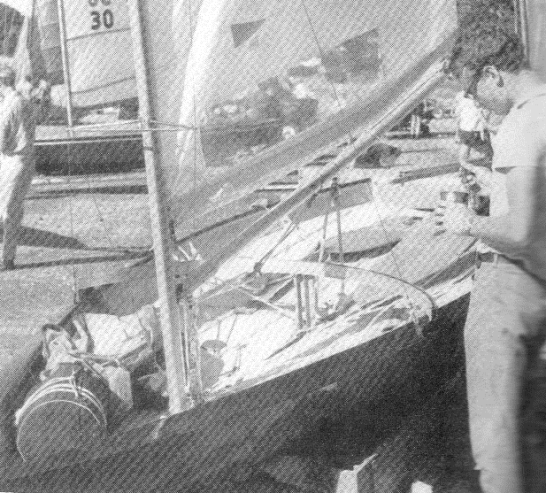Christmas this year is the season of moving, not of giving. With a house, lots of boats and boards to move 11 hours north, Sailcraft is taking a bit of a hibernation. But to keep the blog ticking along, I’m going to post some plans and pics of some lesser-known boats from great designers that I have scanned while storing and stacking magazines.
The Gwen 20
Australian designers Charlie and Lindsay Cunningham were among the most innovative and diverse of small-boat creators. Their first great work, the Gwen 12, was designed during WW2 and arguably set the pattern for post-war Australasian design. A lightweight (for its day) hard-chine planing hull topped by a big rig and powered by a trapeze (it appears to have been the first one design to adopt the trap), it shocked the skiff world by proving faster than the 12 Foot Skiffs. The Gwen became a popular class for decades but has now vanished.
The Cunninghams followed the 12 with the Gwen 20 – a much bigger version of the same style. Only one or two were built, because in the early 1950s the Cunninghams moved to catamarans. Their Yvonne design of 1952 became arguably the first modern catamaran class, beating the Shearwater which normally gets the credit. The smaller singlehanded Quickcat came along soon after and was enormously popular for years before vanishing completely. The appeal of the cats killed off the Gwen 20 and this plan is the only illustration I can find of it.

In later years, the Cunninghams became famous for their Quest line of C Class cats, which won the Little America’s Cup, and then breaking the world sailing speed record with the wingsailed proa Yellow Pages Endeavour.
The Monarch
The Monarch was an 18ft/5.5m two-person version of the Contender, also created by Ben Lexcen. The Contender is another design that I’m going to cover in detail, along with some of its competitors in the great singlehanded dinghy trials of the 1960s.
Like the Gwen 20, the Monarch vanished basically without a trace. All I can find of it is the boat test that supplied these pictures, and a mention in a yardstick listing. I’ve often thought that a Contender could be an interesting boat for those who want to be able to sail either one up or two-up, and perhaps the Monarch could be worth a closer look to see how Benny would have looked at the problem.


Bruce Farr Moth and 18 Footer
Before he became a yacht design legend, Bruce Farr was already a big name in New Zealand and Australia for his champion Moths, 18 Footers and 12 Foot Skiffs. As they say, more to come later.


Jack Holt’s Cavalier
The Cavalier was designed for the trials that eventually chose the Contender as a new International singlehanded class. Although she went well she was just 14 ft long, was too small to be fully competitive. She only took part in the first round.
The trials were a fascinating chapter in late ’60s design. I have lines of several of the competitors and will cover the three series soon.

Next up….. a few designs that were anything but great.

One thought on “Minor studies by great masters”